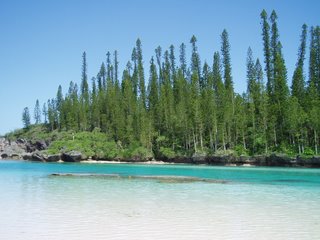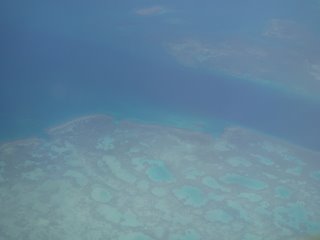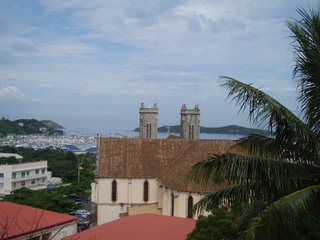New Caledonia: a restless paradise, struggling for independence
In Australia, most people opened round and surprised eyes as I told them my next destination was New Caledonia. I realized most non-francophones have no clue where this place is. So here’s a bit of geography: New Caledonia, a French territory soon (or maybe not) to be independent, is located in the South Pacific between Australia and Fiji, one of the farthest places I could be from home, literally at the opposite side of the globe. I wasn’t sure what to expect. I had seen paradise-like postcards of the area, with turquoise and transparent waters, isolated beaches with fine white sand and of the lagoon around the Grande Terre, (the biggest of the 5 islands, the others being Ouvea, Lifou, Mare and L'ile des Pins) which is one of the largest in the world.
I arrived in Noumea on a Sunday, and as all French cities, there wasn't a shop opened. The busy market place had shut down around noon and so I was left eating Ramen noodles... Even more depressing was the completely dead city center. And even though I was 20,000 km from home, it felt no different from one of the cities on the Cote D'Azur. The sweet and juicy mangoes as well as the flashing red flowers of the Flamboyant once in a while came as reminders of the Pacific. The youth hostel (the single one in New Caledonia) was filled with French expats, just out of university or a bit older, wanting to get away from France and trying their luck in this idyllic place! Many ended up staying at the hostel for a long time while trying to find a job or an appartment. So there were a lot of chill nights playing "belotte" or cooking together. A nice change from India where I ended up being alone with my book in my hotel rooms.
I arrived in Noumea on a Sunday, and as all French cities, there wasn't a shop opened. The busy market place had shut down around noon and so I was left eating Ramen noodles... Even more depressing was the completely dead city center. And even though I was 20,000 km from home, it felt no different from one of the cities on the Cote D'Azur. The sweet and juicy mangoes as well as the flashing red flowers of the Flamboyant once in a while came as reminders of the Pacific. The youth hostel (the single one in New Caledonia) was filled with French expats, just out of university or a bit older, wanting to get away from France and trying their luck in this idyllic place! Many ended up staying at the hostel for a long time while trying to find a job or an appartment. So there were a lot of chill nights playing "belotte" or cooking together. A nice change from India where I ended up being alone with my book in my hotel rooms.
New Caledonia was first encountered by Europeans in the late 18th century by James Cook, who thought the coast line reminded him of Scotland, hence the name New Caledonia (Caledonia meaning Scotland in latin). I don't know where he got that impression from, maybe from the cliffs in Hienghene, because the turquoise-blue lagoon definitely did not remind me of Scotland. After this first encounter, the few Europeans that inhabited the island during the first half of the 19th century were sailors, whale traffickers, adventurers. And it is only around 1840 that a number of French catholic and English protestant missionaries came to convert the indigenous population, the Kanak tribes. Like always, the French and the British didn't agree, but this time the froggies won. And around 1860-1870 Napoleon III sent France's political prisoners from the Paris Commune and from the Kabyl insurrection in Algeria to New Caledonia. An Algerian woman I met in the plane from Noumea to the Ile des Pins actually made a very poignant documentary on the Algerians that had been deported. It's weird to think that this paradise-like island was such a hell for so many prisoners, so far away from their home and their families.
 An example of this paradise, "la piscine naturelle" or "natural pool" gets filled up at high tide and when low tide comes, tropical fish are trapped- amazing snorkelling!
An example of this paradise, "la piscine naturelle" or "natural pool" gets filled up at high tide and when low tide comes, tropical fish are trapped- amazing snorkelling!
 An example of this paradise, "la piscine naturelle" or "natural pool" gets filled up at high tide and when low tide comes, tropical fish are trapped- amazing snorkelling!
An example of this paradise, "la piscine naturelle" or "natural pool" gets filled up at high tide and when low tide comes, tropical fish are trapped- amazing snorkelling!By 1900, the Bagne was terminated and the liberated prisoners were "encouraged," actuallyin many cases, they didn't have much choice but to stay in New Caledonia. Many French officials were also sent to act as a colonial administration... Asian immigrants came to provide the labor force needed for the mining of Nickel (still on-going to this day, with tremendous ecological damage). As a result, the population in New Caledonia is extremely diverse: Melanesians (including the indigenous Kanak population), whites (descendants of the colonizers, of the liberated prisoners that were forced to stay, les Caledoniens, who have lived in NC for 4, 5 or more generations; as well as French expatriates, commonly called les "Zoreilles", who came to New Caledonia in recent years, probably seeking a different life in the Pacific) Asians, Polynesians, Wallisians, Arabs, etc... A great mix!
But, I was quite surprised to see that there wasn't a lot of social "mixing" between the Caledoniens and the Kanaks. In Noumea, it was really clear which were the Kank hang-outs and which were the Caledonien or Zoreilles ones. "La Baie des Citrons" with all its bars and restaurants right on the beach front reminded me so much of Southern France. There, one would rarely see Kanaks (especially at night). The Place des cocotiers centre ville (completely deserted at night) is mostly a place where Kanaks hang-out. When I took the bus to go to the North of the island, to Kone, or even within Noumea to go to the Mont Dore (a bit outside town), I was always surprised to be one of the only white people, which definitely showed something about socio-economic disparities between the different ethnicities.
The Kanaks were actually always very vocal against the French colonization - not surprisingly. Throughout the 19th century, there were many revolts, and then again in the beginning of the 20th century. After WWII, during which NC was a military base for the Americans in the War in the Pacific, the Kanaks hoped to gain independence especially during France's decolonization movement (Indochina, West Africa and North Africa). But France is determined to keep the colony, and the Nickel boom in the 70s brings even more French immigrants to the territory. The 1980s were particularly violent years. In 1988 a group of independentists takes hostage of 22 policemen in Ouvea, which resulted in a bloody assault by the military in an attempt to free the hostages A year later, the president of the FLNKS (Front de Liberation Nationale Kanak Socialiste), Jean-Marie Tjibaou was assissinated by a radical who blamed him for signing the "Accords de Matignon" in 1988 with their opponents in the fight for independence.
So in 1998, the "Accords de Noumea" were signed. They gave the territory more autonomy and stated that a referendum for or against independence would be conducted in 2018. Right now, most of the products are imported and the only industry is Nickel mining (which, by the way, has had many negative impacts on the environment, both the forest and the coral reef). Aquaculture and the cultivation of fruits and vegetables are the biggest agricultural acrivities. Various efforts are made to develop agriculture on the islands like in the islands where Avocado (Mare), Coprah oil (Ouvea) and Vanilla beans (Lifou) production is encouraged. Will this be enough to provide for its population of 200,000? One wonders what will become of the territory if it choses to be independent- I think most "Zoreilles" will have to leave, for sure- and the acces to manufactured goods will be reduced. Maybe, people will go back to living simply, without any materialistic needs, which isn't that bad in the end, and any way, this is quite often the case outside of Noumea, in the bush.
So in 1998, the "Accords de Noumea" were signed. They gave the territory more autonomy and stated that a referendum for or against independence would be conducted in 2018. Right now, most of the products are imported and the only industry is Nickel mining (which, by the way, has had many negative impacts on the environment, both the forest and the coral reef). Aquaculture and the cultivation of fruits and vegetables are the biggest agricultural acrivities. Various efforts are made to develop agriculture on the islands like in the islands where Avocado (Mare), Coprah oil (Ouvea) and Vanilla beans (Lifou) production is encouraged. Will this be enough to provide for its population of 200,000? One wonders what will become of the territory if it choses to be independent- I think most "Zoreilles" will have to leave, for sure- and the acces to manufactured goods will be reduced. Maybe, people will go back to living simply, without any materialistic needs, which isn't that bad in the end, and any way, this is quite often the case outside of Noumea, in the bush.
Source: Wikipedia



0 Comments:
Post a Comment
<< Home